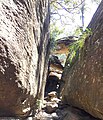Gosford Glyphs
Kariong, Central Coast | |
| Coordinates | 33°27′07″S 151°18′11″E / 33.451833°S 151.303001°E |
|---|---|
The Gosford Glyphs, also known as Kariong Hieroglyphs, are a group of approximately 300
The glyphs have been dismissed as a
While rumours of Egyptian glyphs have existed since the 1920s, a spokesperson for the
In late 2023 the National Parks and Wildlife Service began dislodging boulders it deemed unsafe near the glyphs. These works were criticized by residents and a local environmental protection organization as unnecessary and extreme.[3]
Description
They depict boats, chickens, dogs, owls, stick men, a dog's bone as well as two
Discovery
The carvings were first formally reported in 1975 by Alan Dash, a local surveyor working for Gosford Council who had been visiting the area for seven years without seeing the glyphs. Dash continued to visit for five years and saw new glyphs whenever he visited.
Since then, the hieroglyphs have been claimed by
Authenticity

Professor Boyo Ockinga has said:
"[T]here are many reasons why they are not accepted as genuine hieroglyphics...
"First of all the way they're cut is not the way ancient Egyptian rock inscriptions are produced, they're very disorganised...
"There's also a problem with the actual shapes of the signs that are used. There's no way people would've been inscribing texts from the time of
Cheopsfrom the signs that weren't invented until 2500 years later."
He suggested that the glyphs might have been made in the 1920s by Australian soldiers when there was general interest in ancient Egypt after the uncovering of the Tomb of Tutankhamun at that time. The soldiers, who had served in the Sultanate of Egypt from the mid 1910s to early 1920s, cited an example of shapes in the form of the Sphinx and a pyramid known to have been made by a returning soldier.[1]
Australian Professor of Egyptology
Gallery
-
The parallel walls upon which the glyphs are carved
-
Miscellaneous symbols, including a sphinx and the Eye of Horus
-
Egyptian GodAnubis, the largest carving on the site
References
- ^ a b "Egyptologist debunks new claims about 'Gosford glyphs'". ABC News. 14 December 2012. Retrieved 7 December 2014.
- ^ "The Gosford glyphs, debunked". Australian Geographic. 28 February 2021. Retrieved 18 April 2022.
- ^ Collins, Terry (December 20, 2023). "Outrage over remedial work at glyphs site". Coast Community News.
- ^ a b Coltheart, David (Oct–Nov 2003). "Debunking The Gosford Glyphs". Archaeological Diggins. 10 (5).
- ^ ISBN 978-0-313-37919-2
- ^ The stories and legends behind the hieroglyphs in Kariong by Star 104.5, 21 January 2019. Retrieved 29 September 2020.
- ^ a b Kelly, Matthew (20 October 2012). "Ancient Egyptians lived near Woy Woy: fact or fantasy?". Newcastle Herald. Retrieved 7 December 2014.



